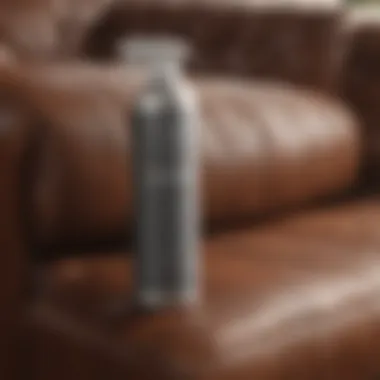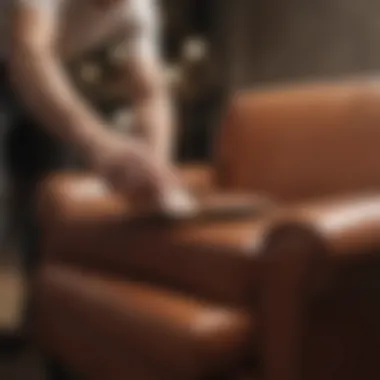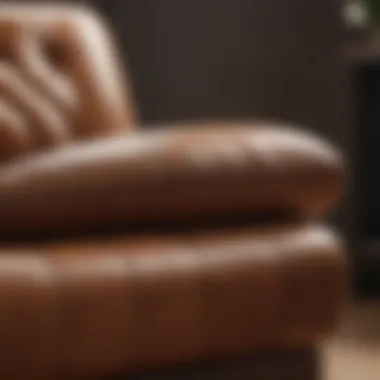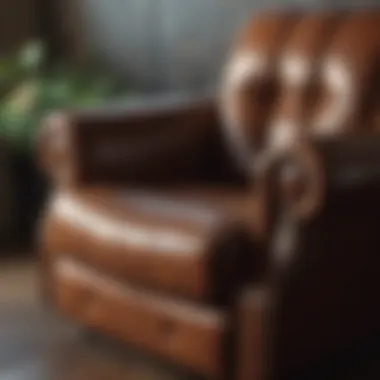Expert Guide to Cleaning Leather Upholstery


Intro
Cleaning leather upholstery furniture is a task that requires careful consideration. Leather, being a natural material, has its own set of characteristics that necessitate a specific cleaning approach. Unlike synthetic fabrics, leather can react negatively to harsh chemicals and improper cleaning techniques. This guide will provide homeowners and professionals with instructional content to properly clean and maintain their leather furniture. Understanding the right methods and products will help preserve the aesthetic appeal and longevity of your leather upholstery.
In addition, it is essential to recognize the importance of preventive maintenance. Regular care can go a long way in ensuring the furniture retains its elegance and functionality. Below, you will find a structured outline on the cleaning process, detailing various methods, required materials, and troubleshooting tips for common issues faced with leather upholstery.
Let’s dive in to learn the best practices for maintaining your leather furniture.
Prolusion to Leather Upholstery
Leather upholstery adds a touch of elegance and sophistication to any room. Understanding how to care for it is essential for maintaining its beauty and durability. This section provides insights into the types of leather and emphasizes the significance of regular cleaning. By grasping these concepts, homeowners can ensure their furniture remains both visually appealing and functionally sound for many years.
Understanding Leather Types
Different types of leather used in upholstery come with unique properties and care requirements. Familiarizing yourself with these types is crucial for effective maintenance.
Aniline Leather
Aniline leather is known for its natural look and feel. It is dyed with soluble dyes, allowing the grain pattern to show clearly. This type of leather is popular because it offers a luxurious touch and comes in various colors. A key characteristic of aniline leather is its vulnerability to staining, as it does not have a protective coating. This aspect makes it necessary to clean spills immediately to avoid permanent marks.
However, while its openness gives it rich texture, it also means that it needs more care than some other leathers.
Pigmented Leather
Pigmented leather is coated with a layer of paint or pigment, making it more resistant to stains and fading. This type of leather is often preferred for furniture that sees heavy use. The main advantage is its durability; it withstands spills and scratches better than aniline leather. Since it has a protective layer, it requires less frequent cleaning. Nevertheless, it might lack the softness and character found in aniline varieties, making it less desirable for those seeking a more natural look.
Semi-Aniline Leather
Semi-aniline leather is a blend of aniline and pigmented leather. It retains some natural features while having a degree of protection from stains and fading. This type is beneficial for those who want a more balanced approach—softer than pigmented leather, yet more durable than aniline leather. The unique feature is its ability to withstand daily wear while still offering a pleasing aesthetic. However, it does require some regular care to maintain its appearance.
Nubuck and Suede
Nubuck and suede are often confused due to their textured surfaces. Nubuck is made from the outer hide and is sanded to create a soft finish. Suede comes from the inner side of the hide. Both are beautiful options but are much more difficult to clean. They can easily absorb moisture and oils, leading to stains that may be hard to remove. While these leathers provide a unique texture and depth, their cleaning needs require extra attention and special products.
Importance of Regular Cleaning
Regular cleaning of leather upholstery is essential for several reasons. This section addresses why maintaining a cleaning schedule benefits both the furniture and its users.
Preventing Stains
Preventative measures against stains are necessary for longevity. Regular cleaning helps to remove dirt and oils that can lead to discoloration and permanent stains. When spills occur, prompt action—using suitable cleaners—can prevent the leather from absorbing harmful substances.
Neglecting this aspect may lead to resultant damage, making it harder to restore the leather's original appearance.
Extending Lifespan
Regular cleaning can significantly extend the lifespan of leather upholstery. Clean leather is not only appealing but also less prone to wear and tear. Establishing a routine helps ensure that your furniture retains its beauty and structural integrity. Skipping routine care can lead to deterioration, as embedded dirt and oils may cause the leather to crack or fade.
Maintaining Aesthetic Value
The aesthetic value of leather upholstery is tied to its appearance and condition. Regular cleaning helps maintain its shine and richness. Given that leather can fade over time, taking proactive steps in its upkeep ensures it looks fresh and vibrant. A well-maintained leather piece adds value to a home, while neglected leather can detract from its overall appeal.
"Cleaning leather upholstery isn't just about appearance; it directly impacts its longevity and value."
Materials Required for Cleaning


Cleaning leather upholstery requires a thoughtful selection of materials. The correct supplies not only elevate the cleaning process but also ensure that the leather remains in excellent condition. Each material serves a specific function, enhancing the effectiveness of cleaning while safeguarding the integrity of the leather.
Essential Cleaning Supplies
Soft Cloths
Soft cloths are an essential item in cleaning leather upholstery furniture. They are gentle enough to avoid scratching the surface while effectively lifting dirt and dust. The key characteristic of soft cloths is their non-abrasive texture. This makes them a popular choice for any leather cleaning process. Unlike rough materials, soft cloths prevent damage to the leather, which can result in premature wear and tear. When choosing soft cloths, look for microfiber options as they tend to trap dirt more efficiently.
Leather Cleaner
Leather cleaner plays a pivotal role in preserving the appearance of leather upholstery. An effective leather cleaner removes grime and stains without causing harm to the material. It is crucial to select a cleaner that is specifically designed for leather, as regular household cleaners can contain harsh chemicals. The unique feature of quality leather cleaners is their ability to condition the leather while cleaning, thus preventing dryness and cracking. This makes leather cleaner a beneficial choice for maintaining upholstery in optimal condition.
Conditioner
Conditioners specifically designed for leather are vital after the cleaning process. They restore moisture, ensuring the leather remains supple and nourished. The most notable characteristic of leather conditioners is their ability to penetrate deeply into the leather fibers. This replenishment is critical because leather can dry out over time, leading to unsightly cracking. Choosing a good conditioner means investing in the long-term health of the upholstery, minimizing the likelihood of future damage.
Optional Tools for Deep Cleaning
While essential supplies are key to maintaining leather upholstery, some optional tools can enhance cleaning. These tools address deeper layers of dirt and enhance overall cleanliness.
Vacuum Cleaner with Attachment
A vacuum cleaner with an attachment for fabric is highly useful in the cleaning process. This tool allows for the removal of dust and debris from crevices that soft cloths may not reach. The advantage of using a vacuum cleaner is its efficiency in removing particles that can accumulate over time, helping to maintain a cleaner environment. However, one should be careful with the settings to avoid excessive suction, which may harm the leather.
Brushes for Tough Spots
Brushes designed specifically for tough spots can significantly aid in the cleaning process. These brushes can effectively eliminate dirt and grime lodged in seams or textured areas of the leather upholstery. The key characteristic of these brushes is their bristle stiffness, which is suitable for use on leather without damaging it. They can tackle tough stains that standard cleaning methods might miss. However, using brushes requires attention to avoid excessive scrubbing, which can lead to wear.
Air Purifier
An air purifier is an optional but useful tool for maintaining a clean living environment, which indirectly benefits leather upholstery. By filtering out dust and allergens from the air, these devices reduce the accumulation of particles that can settle on the furniture surfaces. This creates a healthier living space and keeps your leather looking fresh for longer. Despite their price and maintenance, an air purifier can prove worthwhile for those serious about cleanliness.
Step-by-Step Cleaning Process
The step-by-step cleaning process is a crucial aspect of maintaining leather upholstery. It offers a structured approach that ensures thorough cleaning while minimizing potential damage to the material. Each step in the process is designed to address specific needs, such as dirt accumulation, stains, and the overall aesthetic appeal of the leather. Following this method not only enhances the appearance of the furniture but also contributes to its longevity.
Initial Dusting
Initial dusting is the foundational step in the cleaning process. It involves removing any loose dirt and dust from the surface of the leather. A soft cloth or microfiber duster is generally the best tool for this task. Dust can accumulate quickly and can cause scratches if left unaddressed. By dusting regularly, you can prevent buildup that may lead to more significant cleaning challenges later.
Application of Leather Cleaner
Choosing the Right Cleaner
Choosing the right cleaner is vital for the maintenance of leather upholstery. Each leather type, like aniline or pigmented, may require a specific formulation. A good leather cleaner should be gentle yet effective, removing dirt without stripping the natural oils from the leather. It's essential to read the label carefully to ensure it suits your upholstery type. Using a cleaner designed specifically for leather helps maintain its integrity and appearance, which is very important.
Testing on a Small Area
Testing on a small area before full application is a prudent step. This allows you to observe how the product interacts with the leather. If the cleaner causes discoloration or damage, you can avoid using it on the entire piece. This precaution highlights the importance of due diligence and care in cleaning processes. It also builds confidence in the cleaning products being used.
Cleaning Technique
Using Circular Motions
Using circular motions while applying the leather cleaner is a recommended technique. This method ensures that the cleaner is evenly distributed across the surface. It also helps lift dirt and grime without pushing it deeper into the leather fibers. By employing this method, you can achieve a more thorough clean, which ultimately contributes to the desired outcome of maintaining leather upholstery in good condition.


Paying Attention to Seams and Crevices
Paying attention to seams and crevices is crucial during the cleaning process. These areas often trap dirt and can be overlooked if not cleaned properly. Using a soft brush or a cotton swab can help reach these tight spots effectively. Neglecting these details may lead to long-term damage, making this aspect of the cleaning process especially important for maintaining leather upholstery.
Drying and Conditioning
Ensuring Proper Drying
Ensuring proper drying is an often overlooked yet important step after cleaning. Leather should not be exposed to direct sunlight or extreme heat, as this can cause cracks and fading. It is essential to allow the leather to air dry naturally in a well-ventilated area. Proper drying ensures that the leather retains its shape and finish, preparing it for the next step in maintenance.
Applying Leather Conditioner
Applying leather conditioner after cleaning is a beneficial step in the maintenance process. Conditioner helps to replenish lost oils from the leather after cleaning. This rejuvenation keeps the leather supple and prevents drying and cracking. It's important to choose a conditioner that is compatible with your specific leather type to ensure optimal results. Regular conditioning is part of a long-term care strategy to maintain the furniture's look and feel.
Regular cleaning and conditioning of leather furniture are essential for enhancing its durability and appearance.
Preventive Maintenance
Preventive maintenance is critical when it comes to caring for leather upholstery furniture. Regular maintenance not only keeps your furniture looking its best but also significantly extends its lifespan. Leather, as a natural material, is prone to wear and tear. By adopting a preventive approach, one can minimize the risk of damage and maintain the integrity of the leather.
Regular Dusting Schedule
Establishing a regular dusting schedule is essential for keeping leather upholstery clean and fresh. Dust accumulation can lead to dullness and eventual damage to the leather surface. Use a soft, dry microfiber cloth to gently wipe away any dust. This should be done weekly, or more often if the furniture is in a high-traffic area.
Regular dusting prevents dirt particles from embedding into the leather, which can cause scratches over time.
A systematic approach can help you remember to dust your leather furniture. Consider setting reminders on your calendar or incorporating it into your cleaning routine.
Avoiding Direct Sunlight
Another preventive measure is to avoid placing leather furniture in direct sunlight. Prolonged exposure can lead to fading and drying of the leather material, causing it to crack. If possible, position your furniture in a shaded area. If your space does not allow for this, consider using sheer curtains to diffuse sunlight throughout the day.
In addition to sunlight avoidance, temperature fluctuations can also harm leather. Maintaining a consistent temperature in your home can help preserve the material’s quality.
Using Protective Covers
Using protective covers can be an effective strategy to maintain leather furniture. These covers can shield the surface from dust, spills, and scratches when the furniture is not in use. For instance, if you have pets or young children, investing in a lightweight and breathable cover can save your leather from potential damage.
Choose covers made specifically for leather furniture to ensure they fit properly. Avoid materials that can trap moisture, as this may lead to mold growth.
Troubleshooting Common Problems
Addressing common issues with leather upholstery is a crucial aspect of maintaining its integrity and appearance. Leather, while durable, can still be prone to various problems that affect its longevity and aesthetics. By knowing how to troubleshoot these issues, homeowners can avoid costly repairs and retain the elegant look of their furniture.
Dealing with Stains
Stains on leather can create a challenge, but understanding how to treat them appropriately makes a significant difference. Cleaning stains promptly and correctly is vital to preserving the leather's quality.
Food and Drink Spills
Food and drink spills are common occurrences that can leave unsightly marks on leather. Immediate action is essential when these spills happen. The key characteristic of food and drink spills is that they can vary greatly in composition. Some might be simple stains from water, while others could involve oily residues or dyes from beverages.
It is beneficial to recognize the unique nature of these stains as it allows for a tailored response. For instance, a simple water spill might require just a damp cloth, while a greasy stain necessitates the use of a leather cleaner. Knowing the right approach can make tackling food and drink spills less daunting and prevent them from becoming permanent.
Ink Marks


Ink marks present another challenge for leather upholstery. They can occur from pens, markers, or even ink transfer from clothing. The key characteristic of ink stains is their potential to set quickly. This immediacy often makes ink marks one of the more difficult stains to remove without causing damage.
When dealing with ink marks, it is essential to use specialized leather cleaning solutions that target ink effectively. However, care must be taken as certain products may worsen the stain or affect the leather’s finish. Thus, targeting ink marks with appropriate techniques significantly contributes to leather upkeep.
Oily Residues
Oily residues often arise from foods, hands, or cosmetic products. These marks differ significantly from other stains, as they can not only stain the surface but also penetrate the leather if not addressed in time. The key here is that oily stains can lead to texture changes and a greasy appearance if left untreated.
To manage oily residues, the application of a dedicated leather cleaner designed to cut through grease is necessary. This makes addressing oily substances crucial to maintaining the leather’s original feel and look while preventing long-term damage.
Handling Scratches and Scuffs
Scratches and scuffs are inevitable for leather furniture, especially in high-use areas. Understanding how to treat these problems is essential for preserving your investment in leather upholstery.
Minor Scratches Treatment
Minor scratches are often superficial and don’t penetrate deeply into the leather. The importance of addressing these minor scratches lies in their potential to become more pronounced if neglected. The key characteristic here is their relative ease of treatment. Many home remedies, including leather conditioners, can help minimize their appearance.
Using a soft cloth and gentle rubbing with conditioner can help blend minor scratches with the surrounding leather, making them less noticeable. This approach is beneficial for homeowners looking to maintain the pristine quality of their furniture without requiring professional interventions.
Deep Scratches Solutions
Deep scratches, on the other hand, pose a more significant challenge. These markings cut into the leather and can expose the underlying materials. The importance of handling deep scratches responsibly cannot be understated; improper treatment could lead to further damage.
Utilizing specialized leather repair kits is often the best approach for deep scratches. These kits typically include tools, fillers, and dyes designed to restore the leather’s appearance. Taking these steps ensures that even deep scratches can be treated effectively.
Restoring Faded Leather
Faded leather is a common issue, especially for items exposed to sunlight for extended periods. Recognizing how to restore leather properly can rejuvenate its overall look significantly.
Color Restoration Techniques
Color restoration techniques are essential for maintaining the vibrancy of leather. Over time, exposure to light or neglect may lead to a dull appearance. The key characteristic of color restoration techniques is their ability to reinvigorate leather furniture while being relatively straightforward for most homeowners to apply.
These techniques often involve cleaning, followed by the application of leather dyes or conditioners meant to enhance color. This can restore the leather’s youthful tone, making it a recommended choice for anyone looking to breathe new life into faded upholstery.
When to Seek Professional Help
While many issues can be addressed at home, some problems require the expertise of a professional. The importance of knowing when to seek help lies in preventing further damage to the leather. Certain damages, particularly severe stains or deep structural issues, may not respond well to DIY techniques.
Professionals have access to advanced tools and techniques that can ensure a quality restoration. Understanding the limitations of home methods and recognizing when professional assistance is needed ensures the long-term care and preservation of leather upholstery.
Ending
The conclusion serves as the final touchpoint in this discussion on cleaning leather upholstery furniture. It synthesizes the key aspects presented throughout the article while reinforcing the necessity of regular maintenance and appropriate cleaning techniques. Understanding the significance of proper care can not only prolong the life of leather furniture but also enhance its aesthetic appeal.
Summary of Key Points
To summarize the key points:
- Types of Leather: It is important to recognize the different types of leather. Each type, such as aniline, pigmented, semi-aniline, nubuck, and suede, demands particular cleaning methods.
- Materials for Cleaning: Selecting the right cleaning supplies, like soft cloths, leather cleaners, and conditioners, is vital. Optional tools can aid in maintaining cleanliness more efficiently.
- Cleaning Process: A structured cleaning process is crucial. This includes initial dusting, applying the proper cleaner, and ensuring the leather dries correctly.
- Preventive Maintenance: Regular upkeep can prevent severe damage. Avoiding direct sunlight and using protective covers are simple yet effective tactics.
- Troubleshooting: Knowing how to tackle common problems such as stains, scratches, and fading can save frustration and costly repairs.
Encouragement for Regular Care
Regular care for leather upholstery furniture cannot be overstated. Establishing a consistent cleaning routine helps to maintain the leather's appearance and integrity.
Consider the following points:
- Set a schedule for dusting and cleaning to integrate it into your home care practices.
- Pay attention to environmental factors, like sunlight exposure, that can affect the leather.
- Treat small issues promptly to avoid more extensive damage later on.
By committing to these practices, you preserve the luxury and comfort that leather provides. Your furniture serves as an investment, and maintaining it not only preserves its value but also contributes to the overall ambiance of your space.
Proper care of leather furniture is not merely a routine task; it is an investment in the longevity and beauty of your living spaces.



